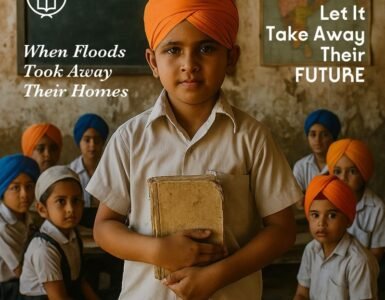Heartbreak Behind the Stats
Disasters are often summed up in statistics.
The Punjab floods 2025 tell a grim story in numbers—13+ districts battered, over 2,200 villages submerged, and 2.2 million acres of farmland swept away.
These figures reveal the scale of devastation but not the heartbreak behind them. According to The Hindu’s report, the floods directly impacted nearly 20 lakh people across 2,614 villages, forcing over 6.8 lakh residents to abandon their homes.
Numbers can’t show what it feels like when floodwater climbs your staircase, one step at a time.
They don’t echo the cries of buffaloes before the current pulls them away, or the sight of an elderly woman clutching her steel trunk—the only thing she could save.
Statistics don’t capture the taste of fear in muddy rainwater, or a mother’s quiet whisper as she holds her child on a rooftop under the August sky.
The government’s data record confirms 55 lives lost, but local eyewitnesses, rescue volunteers, and village panchayats feared the real number is far higher.
The real impact of the Punjab floods 2025 lives in these moments—where loss, courage, and resilience speak louder than numbers.
Tears on Rooftops: Families Fight to Survive
In Hoshiarpur, a grandmother tied together charpoys to build a makeshift raft, desperate to save her grandchildren.
In Fazilka, a farmer hauled his goats onto a tractor, knowing they were his last source of livelihood.
In Tarn Taran, women waded chest-deep through swirling floodwaters, balancing pots on their heads while children clung to their waists.
This was the reality of the Punjab floods 2025.
In August, the overflowing Sutlej, Beas, Ravi, and Ghaggar rivers—swollen further by heavy dam releases from Bhakra, Pong, and Ranjit Sagar—turned rich golden fields into endless lakes. Many near the Sutlej vanished without warning. Livestock perished, homes collapsed, and ripening paddy lay buried under layers of silt.
The absence of timely alerts turned a natural disaster into human tragedy. Across Pathankot, Gurdaspur, and Ferozepur, the floods left behind more than just water—they left a landscape of disrupted dreams and untold resilience.
Neighbours Become Saviours
Amid the devastation of the Punjab floods 2025 rose something stronger than the waters—community. When disaster struck, the first responders weren’t officials or rescue teams; they were neighbours. Villagers hauled stranded families onto tractor trailers and shared sacks of flour by candlelight.
Even before the rain stopped, gurdwaras opened their doors. In langar kitchens across Punjab, dal and rotis simmered nonstop—seva, the spirit of selfless service, in motion.
The response was messy, improvised, and immediate, but it reflected true Punjab resilience.
When waters rose, people didn’t wait—they acted.
Punjab Floods 2025 Real Heroes: NGOs Lead the Way
As the Punjab floods 2025 battered the state, the transition from chaos to hope was marked by swift, coordinated relief led by dedicated NGOs and community trusts. Prominent groups like the Shiromani Gurdwara Parbandhak Committee set up emergency shelters, while organizations such as Sukhmani Sewa Society Fazilka, Khalsa Aid, UNITED SIKHS, and Sarbat Da Bhala Charitable Trust braved waist-deep floodwaters to deliver ration kits, milk, and essential medicines into devastated villages.
For children stranded by rising water, Dream Buds Foundation, VOA, Drishti Foundation Trust, and the 5 Rivers Heart Association provided warmth and care.
The Kalgidhar Society of Baru Sahib anchored the largest independent operations, leveraging its network of 130 rural schools and converting 15 Akal Academies into lifelines—with classrooms serving as family dorms, courtyards as ration warehouses, and playgrounds repurposed into medical clinics and repair workshops.
The Kalgidhar Trust’s contributions were especially noteworthy. Beyond running shelters and food aid, the Trust was given the crucial responsibility of disposing of animal carcasses to protect public health and prevent the spread of post-flood diseases—a major challenge as livestock losses surged. With its deployed JCB machines and dedicated volunteers, Kalgidhar Trust worked tirelessly to remove and safely bury animal carcasses, ensuring sanitation and dignity in the hardest-hit areas.
The Kalgidhar Trust is also known to have decades of experience doing fast and organized relief work whenever there is a calamity and a chance to do selfless Sewa or service. They have been with them from the day the floods hit, and even now they’re building permanent homes for the devastated ones.
Their relief work received heartfelt recognition from the Indian Army. Colonel Viplav Anand, commanding officer of the 324 Regiment, praised and honoured the Kalgidhar Trust with a personal letter of appreciation for its outstanding support in rescue and rehabilitation efforts. This acknowledgment highlighted how humanity and selfless service triumphed even in Punjab’s toughest times, symbolizing a powerful partnership between civil society and state agencies.
The work did not go unnoticed. The media also helped spread the news so that more people could be helped.
Thousands of volunteers—students and alumni—came together to cook nonstop langar, administer medical care, and vaccinate against cholera. These civilian heroes worked shoulder-to-shoulder with the National Disaster Response Force, district officials, and the Indian Army’s Western Command, powering boat rescues, clearing roads with JCB machines, and constructing vital embankments. The Army openly honoured these tireless efforts, while social media reflected the spirit of partnership—women serving meals to soldiers and volunteers loading supplies for frontline rescue teams. Together, these organizations and individuals showed that the real force behind Punjab’s survival was not just official agencies, but the extraordinary spirit and dedication of its people.
From Ruins to Roofs: True Recovery Begins
From ruins to roofs: true recovery began as relief efforts shifted to long-term rehabilitation. The Kalgidhar Society took a leading role by constructing prefabricated homes—durable one- and two-bedroom units equipped with kitchens, and toilets. These were not mere tents, but real houses that restored not only physical shelter but also psychological hope, allowing families to step from ruins into renewed lives. Meanwhile, the state government announced a ₹1,600 crore relief fund, but the vast scale of damage—billions lost in crops, homes, and livelihoods—far exceeded available aid. Many families waited in vain for government assistance that was too slow to arrive.
This funding gap was bridged by the compassionate efforts of trusts, NGOs, volunteers, and corporate partners including Amazon, Infosys, Nestlé, Sigma Corporation, Indus Valley, Donatekart, and The Better India. Their pooled resources, donations, and logistics turned promises into bricks, seeds, and vital support for flood-battered villages. Alongside building homes, the Kalgidhar Trust also handled the critical task of safely disposing animal carcasses using its JCB machines to prevent disease spread, an often overlooked but essential part of recovery. These combined actions symbolized a community pulling together, turning tragedy into resilience and showing that true recovery depends on both heart and hands working together.
Unbreakable: Punjab’s Spirit Shines Through
Punjab’s strength isn’t just in its farms—it’s in its people. When the 2025 floods hit, affecting 13 districts and submerging about 1,400 to 2,000 villages, the spirit of Punjab didn’t break. A farmer in Ajnala offered tea from his half-submerged home, asking, “Cha piyoge?”
This simple act touched the heart of an Lallantop reporter covering the floods. Children laughed as they waited in langar lines at Akal Academies, and volunteers with blistered hands dug trenches. Though millions of acres of farmland were lost, communities stood strong, supporting each other when the ground gave way. Their resilience was quiet but unbreakable—a true reflection of Punjab’s heart.
Also See: View more stories from the flood lands of Punjab
Heroes Who Rebuilt Lives, Not Just Walls
During the Punjab floods of 2025, the heroes were not just those who rebuilt walls but those who restored lives with humility and service. The Kalgidhar Society, through its Akal Academies, trusts, and dedicated people, refused to give in to despair. They focused on rebuilding real homes, not just temporary shelters, offering one- and two-bedroom prefabricated houses with kitchens, toilets, and verandahs to flood-affected families. This effort restored more than shelter—it revived hope and dignity. Punjab continues to rebuild fields and homes, but above all, it has already restored the faith and spirit of its communities through seva, true selfless service.
What Punjab rebuilds isn’t just walls—it’s lives.
Quick Stats: Punjab Floods 2025 at a Glance
| Impact | Details |
| Districts Battered | 13 (Pathankot, Fazilka, etc.) |
| Villages Submerged | 2200 |
| Acres Destroyed | 2.2 million |
| Lives Lost | 55+ |
| Relief Lifelines | 15 Akal Academies |
| Homes Built | Prefabricated units |
| Fund Announced | ₹1,600 crore (insufficient) |
| Deficit Fund Bridged By | Trusts, NGOs, Volunteers |
Punjab is on its way to reclaim its identity as revival and rebuilding continue. But the aspect that needs immediate attention is the continuity of education. Books and stationery have been swept away by the floods, but this can’t be an excuse as long as we, Indians from other states, are here. Just as our children attend schools, children in Punjab deserve the right to uninterrupted education. If you believe disaster should never block education, make a bold humanitarian move and contribute by sponsoring a child’s education as if they were your own.
#Akal-Relief-Homes

















Add comment